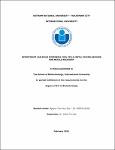| dc.description.abstract | Improper management of dumped tailings not only causes a potential waste of
resources but also poses a direct threat to the lives and the environment. The
Microbial Fuel Cell was used in the study to extract metals such as Iron, Copper
from the electronic waste at lab scale. A mixed of bacteria in anaerobic sludge at
Heineken factory is transferred into the anode of MFCs. The bio-hydrometallurgy
reaction include oxidization reaction in the anode chamber and reduction reaction in
the cathode chamber. The oxidization reaction produces H+, which is continually
transferred through proton exchange membrane to react with O2 in cathode
chamber to generate H2O2 and increases the reaction speed in the anode chamber.
The approach of MFC, recovering metals as well as electrical energy, is ecofriendliness.
Each of treatment was run in 16 days once time, include 2 times for
iron electrode, 2 times for copper electrode and change the water in every time to
check the stability of MFCs. MFCs models produced the highest electricity at 0.988V,
efficiency removed COD at 96.8%, efficiency desalination at 39%. Additionally, the
concentration of Copper, Iron, H2O2 reached a peak at 0.3 mg/L, 1.4 mg/L,
0.9mg/L, respectively. Therefore, it is possible to use MFCs models for bioleaching.
Key words:
Microbial Fuel Cell
Bioleaching
Metals recovery
Anaerobic sludge | en_US |


